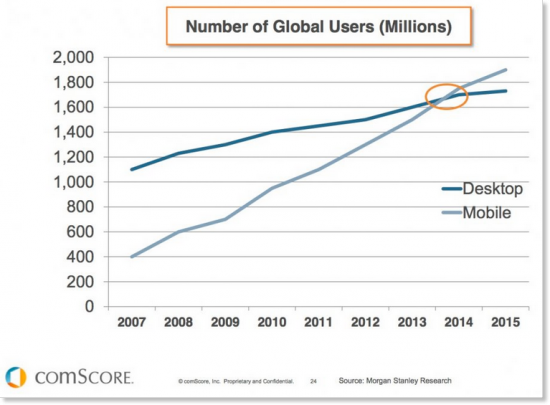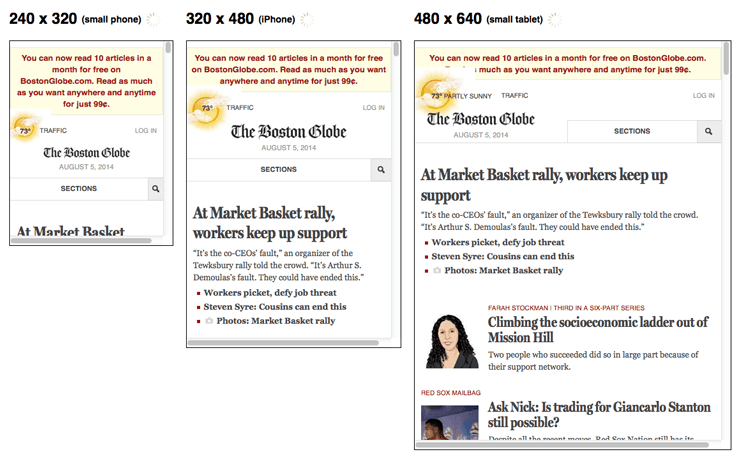by admin | March 27, 2015 | Industry Trends, Paid Search, Uncategorized
Why Do You Need a Mobile Website?
With technology constantly growing and advancing, the average website now receives approximately 60% of its traffic from a mobile device.[1] Google reports that 94% of people with smartphones search for local information on their phones and 77% of mobile searches occur at home or work, places where desktop computers are most likely to be present. In 2014, the number of mobile users surpassed the number of those using a desktop. These statistics confirm the growing popularity and need for a company’s mobile presence online, including the need for a well-constructed mobile website.

Updates to Mobile Search
In April 2015, Google will introduce mobile-friendliness as part of their search algorithm. This update will put emphasis on sites designed for mobile search and give priority to these pages in search results.
Google has also made a number of display updates for mobile search results, including separating results with a colored line
and app indexing, where users will be served a link to a previously downloaded app if appropriate. Google now labels mobile friendly websites directly within search results. Having this label may help increase click through rates, as users know a mobile friendly website is more likely to load quicker and will be easier to navigate on their device. You may also see the word “slow” next to websites with long page load times.
Google also has available a Mobile Usability report within Webmaster Tools and a PageSpeed Insights tool for mobile sites. This is a great start for understanding where your website currently stands in terms of mobile usability.
What is a Mobile Website?
The most common type of mobile website uses a “responsive design.” A responsive design website is a single website coded to “respond” to the device of a user. With this design, the website can adapt by changing the width of columns, text size, button spacing, etc. to offer optimal mobile viewing for the user.

Another type of mobile website is the “M.” site (m.site.com), which creates a separate mobile website. These sites are becoming less popular as they often provide a poor user experience and require much more coding to maintain. Mobile-only pages also need to build up their own reputation (content, links, etc.) because they do not receive shared indexing signals from an existing desktop version of the page.
[1] http://smallbiztrends.com/2014/07/online-traffic-report-mobile.html
by Charles River Interactive | March 4, 2015 | Search Engine Marketing, Uncategorized
Earlier this year, Google started including brands’ social profiles within its Knowledge Graph panel. In the past, this feature only applied to famous people, such as actors, musicians and politicians. What does this mean for brands that Google will now pick up their social handles?
Branded search results are hugely important; this addition of social profiles makes it clear that:
• If your brand is already active in the social space and has a great presence, it will have even a better visibility in search results.
• If you haven’t had the time to build out your brands’ social profiles, this is yet another reason why you absolutely should. ASAP.
(more…)
by admin | June 27, 2014 | Local SEO, Paid Search, Search Engine Marketing, SEO, Uncategorized
Since its launch in 2011, there has been reluctance among many marketers and non-marketers to embrace Google+ as a preferred social platform. Any mention of Google+ is usually met with an eye roll and the common (often-rhetorical) question: ‘Who even uses Google+?’ What has been lost on some, however, has become an advantage for others, considering the Google-owned social network functions hand-in-hand with local search and organic search display.
You can find local search influence in the Google Carousel, Google Maps, and on mobile devices – all three pull from Google+ and local search.
Google+ commands 300 million users and influences 43% of all Google searches with local query intent. Since the early years of Google’s social network, there have been several updates to increase ease of use. Previously known as Google Places, which became Google+ Local, the platform evolved last week to become Google My Business. The recent launch of Google My Business has changed the way we utilize Google products through the successful integration of social, search, and maps, all of which provide a better experience for customers worldwide (Google My Business is available in 236 countries and 65 languages).
Two of the most important updates in Google+ evolution are the improved user experience and cleaner dashboard operating system, as Local SEO experts have been bemoaning both for years. Google took notice and delivered a strong solution with Google My Business.
Google My Business Updates – in plain English
(more…)
by Charles River Interactive | June 5, 2014 | Organic Search, Uncategorized
We came across this video yesterday of a Panda 4.0 discussion between Eric Enge and Mark Traphagen of Stone Temple Consulting with David Harry (SEO Dojo) and Bill Slawski (SEO by the Sea). It’s good stuff, check it out!
https://plus.google.com/u/0/events/c9ousfff9tqb1hmqj64hqgi55ro
Not only is there some good stuff on Panda 4.0 but also some good points on how Google updates the algorithm vs. actual penalties.
by Charles River Interactive | April 18, 2014 | Analytics, Uncategorized
On April 2nd, Google announced that the Universal Analytics product was moved out of Beta and ready for primetime.
Yes, like Deion Sanders but also completely different…
Is Universal Analytics really ready for “primetime”?
Here at CRI, previous to this announcement, we were hesitant to instruct clients to upgrade to the latest version of Google Analytics because it was missing a critical component for Search Marketers – Remarketing.
The move of Universal Analytics out of Beta was part of Google’s Phase 3 (of 4) for the rollout of Universal Analytics. This phase included Remarketing; (more…)

by admin | April 14, 2014 | Search Engine Marketing, Uncategorized
Charles River Interactive of Lexington Moves to Accommodate Rapid Growth
Lexington, MA, April 1, 2014
Mark Desrochers of Westford, MA, president and founder of Charles River Interactive, announces the move of Charles River Interactive corporate offices from Lexington, MA to double the quarters at 890 Winter St. in Waltham. Charles River Interactive will move operations to the new facility in Waltham, MA to accommodate an employee count that has doubled over the last 18 months. The new office increases individual work space to improve efficiency, provides multiple conference rooms to host a large regional customer-base, and allows for future employee growth.
Charles River Interactive is a digital marketing agency specializing in search marketing and web analytics. “Our customer-base has grown significantly over the last few years and we’ve enjoyed the ability to hire key internet marketing talent,” states Desrochers. “This new space is not only a step up in square footage for us, but it’s also a significant step up in quality of space including not only the work environment but also amenities for our employees. Internet marketing, including search engine optimization and pay per click are recognized as integral pieces of company’s marketing budgets and strategies,” says Desrochers, “we expect continued robust growth.”
About Charles River Interactive
Charles River Interactive helps clients meet their varied business goals through cutting-edge search engine marketing (SEM) and social media strategies. CRI is made up of industry-leading organic search, paid search and web analytics experts, as well as experienced project and account managers. CRI takes a highly consultative approach to developing holistic SEM strategies that are backed by data and designed to meet clearly identifiable business goals. Account teams work closely with clients to educate website stakeholders on the key components of search and we strive to integrate search marketing principles throughout each aspect of a client’s overall marketing strategy.



